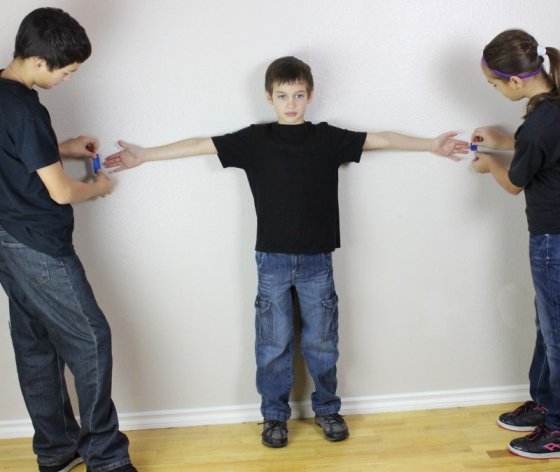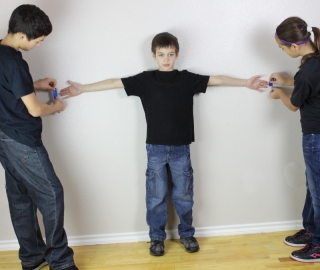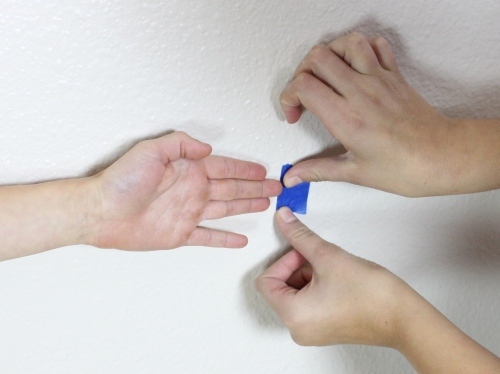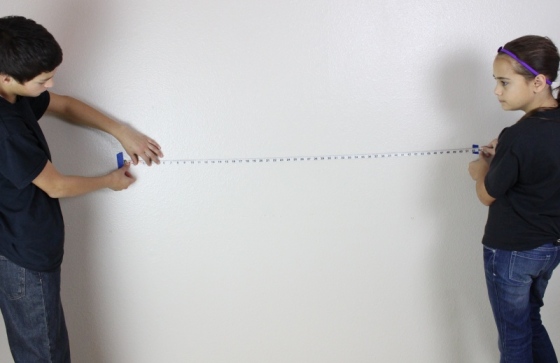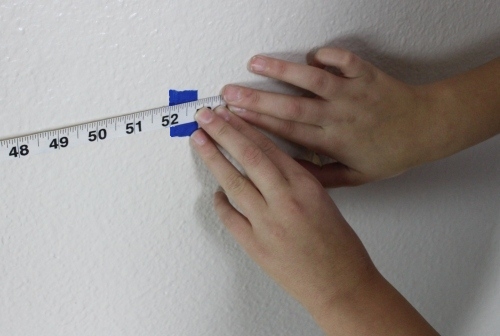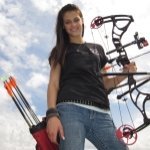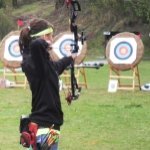Learn How To Determine
Your Proper Draw Length
The process of finding your proper draw length is not rocket science but getting it correct is vital to your success.
Selecting your proper draw length is equally important as choosing the right size shoe.
If you are a runner and your shoe size is too big your performance will not be so graceful.
If your shoe is too small, then you are guaranteed to experience some pain even if you are walking only a short distance in them.
Just like a pair of shoes that are made to fit a certain size foot, every bow is designed to accommodate a specific range of human factors including arm length or draw length.
It is impossible for an archer to learn proper archery shooting form if the draw length and bow size are too small.
This applies to both compound and recurve archers.
My Proper Archery
Equipment Checklist
- Eye Dominance
- Right or Left Hand
- Proper Bow Size
- Proper Draw Length
- Proper Draw Weight
- Proper Arrow Size
Conversely, if the bow is too large for the archer then you will be missing out on the full potential of the stored energy for the bow and the compound shooter will not be able to anchor at all because the nock point will be located to far behind the face.
Regardless of the bow type or archery style you choose, before you can purchase your first bow you will need to know 3 things.
- Draw Length
- Bow Size
- Draw Weight
Before you can determine your proper bow size you first need to determine your proper draw length.
I also address proper bow size here and proper draw weight here, which are both vital to your success as well!
The information on this page will help you determine your proper draw length which you will use to identify a bow size that is right for you.
In your search for answers you may have already come across other methods and variations for determining your proper draw length but rest assured there are only two methods that you should be using exclusively...
On this page I will explain how these two methods work in determining your proper draw length.On a separate page I will demonstrate why I don't use the other methods and why the suggested methods for determining proper draw length for compound bows is risky.
If you are trying to identify your proper draw length for a compound bow you can use the methods on this page or you can skip to Determining Proper Draw Length for compound bows here.
For everyone else, let's get started.
If you are selecting your first bow then finding your calculated draw length (Method 1 Calculated Draw Length) is sufficient enough for identifying your proper bow size if you follow my recommendations.
Using Method 2 (ATA Draw Length Standard) will assure a more precise measurement but again, the first method is adequate for new archers.
Both methods are simple and allow you to find your proper draw length in just 3 minutes!
Note that the two methods apply for youth and adult archer's alike.
Proper Draw Length
Method 1: Calculated Draw Length
This process is fast and easy and it works great for both compound and recurve archers.
There are two simple steps to finding your Calculated Draw Length.
- Measure your arm span
- Divide by 2.5
I like to call this the Measure and Divide method. The archery community has been using this tried and true method to calculate proper draw length for many years...why?
...Because it works!
To determine your calculated draw length you will use a tape measure and some simple math.
No rocket science required for this step, but you will need an assistant to help you measure.
Here is how it works...
Step 1
Stand like you are making the letter T. Now measure your arm span from finger tip to finger tip.
NOTE:
- Stand up straight with arms reached out and palms open (facing forward)
- Make sure your shoulders are not scrunched up or the chest over extended
- Just stand natural and relaxed otherwise you could affect the measurement
Now have your assistant measure with a tape measure from the tip of one middle finger to the tip of the other middle finger.
An alternate method determining your proper draw length is to stand with your back against a wall.
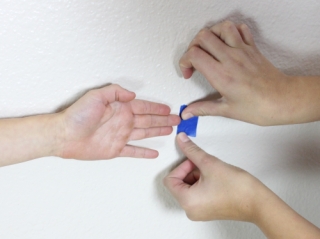
Place the marks on the wall to indicate the end of each middle finger.
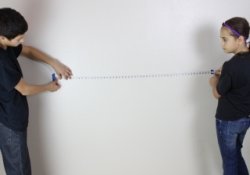
Then simply measure the distance between the marks on the wall.
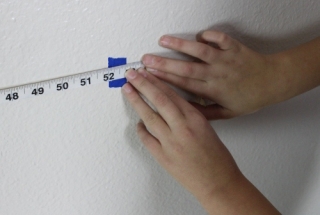
Record this measurement (in inches) as "Arm span".
I prefer determining proper draw length with this method because the flat wall aids the person in standing upright and is much easier to see, then correct, scrunched shoulders or an expanded chest.
Step 2
Divide your arm span measurement by 2.5.
The following example is based on an Arm Span measurement of 52 inches.
Measure and Divide Example
Inches
52" ÷ 2.5 = 20.8"
The answer will be a calculated draw length . In this example it is 20.8 inches.
Of course your actual results will be different from my example.
Record your calculated draw length number.
Suggestion:
Round-up your calculated draw length to the nearest 1/2 inch.
For instance, in this example the calculated draw length will be 21 inches.
That's all there is to it folks!
Remember, your calculated draw length is enough information for a new archer to select a proper bow size.
You can use your Calculated Draw Length and move on to the next step to find your proper size bow by going here.
If you want a more precise measurement in determining your proper draw length and you have access to a suitable bow, you can use the ATA Draw Length standard method explained below.
Proper Draw Length
Method 2: ATA Draw Length Standard
(Actual Draw Length)
(ATA - Archery Trade Association formerly known as AMO - Archery Manufactures Organization).
ATA assists in establishing measurements standards within the archery community.
According to ATA...
Draw length is the distance at the archer's full draw, from the nocking point on the string to the pivot point of the bow grip plus 1 3/4 inches.
Draw Length (DL) from the Pivot Point (PP) shall be designated as DLPP and shall be called TRUE DRAW LENGTH.
Phew! That's a mouth full.
It sounds confusing but it is quite simple - I'll explain.
ATA Draw Length Standard or True Draw Length
Here is how it works...
- The archer will draw the bow to the proper anchor position
- Your assistant will measure from the Nock Grove (apex of the string) to the Pivot Point (PP) of the bow grip
- Now add 1-3/4 inches to that distance
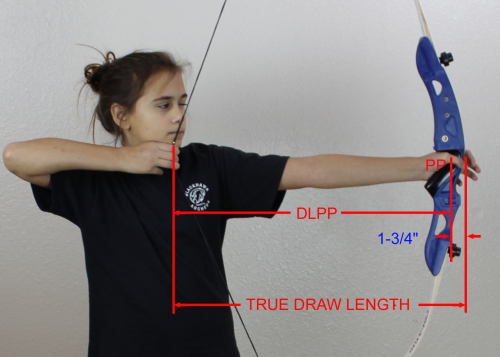
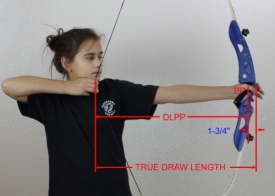
That's it! Now you know your true draw length.
Pretty simple isn't it?
Here is a tip that makes finding the ATA true draw length even easier.
A great deal of modern day bows are manufactured with a distance of 1-3/4 inches from the pivot point to the back of the bow.
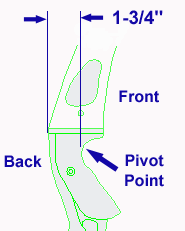
So, if you are using a bow that is 1-3/4 inches from the pivot point to the back of the riser all you need to do is measure from the nock grove or nock point at full draw to the back side of the bow to find true draw length.
Remember that the ATA true draw length is the distance at the archer's full draw, from the nocking point on the string to the pivot point of the bow grip plus 1-3/4 inches.
Where is the Nock Grove?
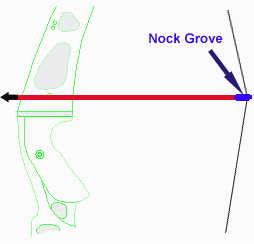
The nock grove is the part of the arrow that snaps on to the bowstring.
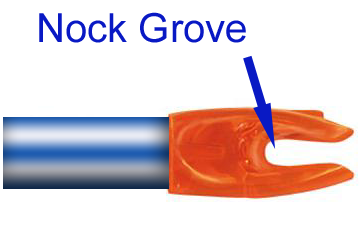
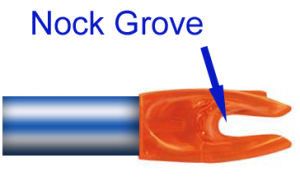
It is important to note that the portion of the nock that extends past the string is not included in the measurement.
I use the ATA draw length method when outfitting most of my archers but it only works if you have an appropriate bow on hand AND you know what proper shooting form actually looks like.
If you do not have access to a bow then you can use the measure and divide method to find your calculated draw length.
Important Tips:
- For either method, if the archer being measured does not have proper shooting form then they WILL NOT achieve proper full draw and anchor position. Consequently you may not identify your True Draw Length.
- When using these methods, it is important that the archer does not raise or scrunch up their shoulders. The chest should not be collapsed and the elbows and arms need to be properly aligned to the arrow shaft or you will get false readings.
- If you are a beginner or inexperienced and you choose to peruse either of these methods at home my recommendation is DO NOT LOAD AN ARROW and make certain you do not dry-fire the bow.
- Dry firing a bow (releasing the string without an arrow) can/will damage the bow and cause injury...but you are likely to have a more serious incident if the archer accidentally releases an arrow.
You have enough information to determine your proper bow size, go here now...
Coach's Corner
Important!
Draw Length Myths
Before you head off to determine your bow size you should be aware of some of the common archery myths concerning how to determine your proper bow size.
There are a number of websites and on-line retailers who use two types of charts to determine proper bow size and they both completely ignore the first step of determining proper draw length.
If you understand the fairy tale behind these charts, your new bow will not end up in a dark closet or hanging on a wall collecting dust bunnies.
Go here to learn about these myths...
To learn why matching draw length to bow length are important go here...
Have A Question About Determining Your Proper Draw Length?
Was This Page Helpful? Please Leave Your Feedback
Was This Page Helpful? Please Leave Your Feedback
Do you have a question about determining your proper draw length? Do you have an experience to share? Was this page helpful? We appreciate your feedback so we can improve this page. Here is the place to do it...
What Other Visitors Have Said
Click below to see contributions from other visitors to this page...
Length Of Longbows Of Old 




This was very helpful, but I was wondering if the Longbows of old were really as long as the shooter was tall?
Clear and Simple 




Best explanation I have come across. Instructions clear, concise and well illustrated.
Very Helpful Not rated yet
I am new to the idea of archery and plan to join a club as a beginner in the near future. I love working with wood and I have always wanted to build bows, …
![]()
Copyright © 2017 Learn-Archery.com All rights reserved
Learn-Archey.com is my personal site. It accepts advertising and other forms of compensation.
Such compensation
does not influence the information on this site. I always give my honest opinions, findings, beliefs, or experiences.

